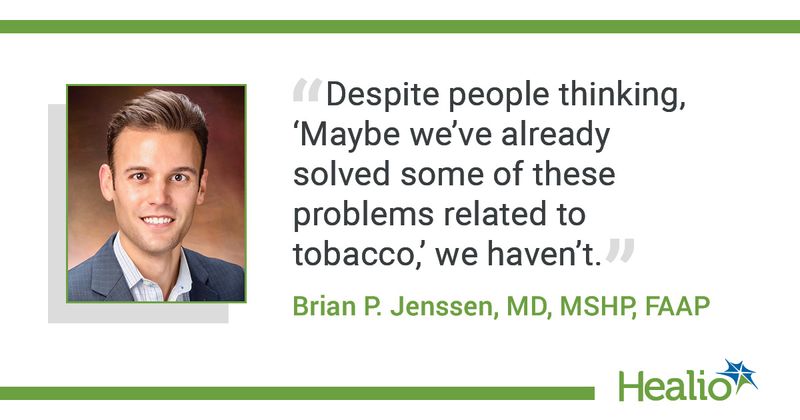AAP updates policy against tobacco, nicotine
Key takeaways:
- The AAP updated its guidance on tobacco and nicotine for the first time since 2015.
- Pediatricians are “uniquely positioned” to assist in prevention, co-author says.
The AAP has published an updated version of its policy against tobacco and nicotine products, which includes a recommendation that pediatricians help prevent use among children.
According to the FDA, almost 90% of smokers began smoking before age 18 years, when the body and brain are especially vulnerable to addiction. In last year’s National Youth Tobacco Survey, more than 3 million middle and high school students in the U.S. reported continuous tobacco use in 2022.

The AAP updated its policy statement on tobacco and nicotine for the time since 2015. The statement was accompanied by clinical and technical reports.
“Five to 7 years is a long time ... a lot of new evidence is contributing to our understanding of the topic and the key clinical and policy approaches to address it,” Brian P. Jenssen, MD, MSHP, FAAP, an associate professor at the University of Pennsylvania Perelman School of Medicine and lead author of the policy statement, told Healio.
“So, that's where we as a group decided this is a perfect time to look again at the literature and either continue forward with our recommendations or update and add new key recommendations,” Jenssen continued.
Among the recommendations, Jenssen and colleagues said the FDA should regulate all tobacco and nicotine products to protect public health, that tobacco sales only to people aged 21 years or older be enforced, that prices on tobacco products be increased to deter children and adolescents from trying to buy them, and that tobacco industry-sponsored mass-media and school-based tobacco control programs should be prohibited.
“We need to expand funding to efforts to help prevent individuals from picking up the products in the first place, and then [help] those who are addicted push back,” Jenssen said.
Although most of the statement focuses on policy, it also includes clinical recommendations and ways that pediatricians can assist in prevention.
“We emphasize what pediatricians can do, and that includes helping with prevention,” Jenssen said. “They can make sure that teenagers are aware of the issues related to tobacco products [and] that tobacco companies are trying to target [the teen demographic].”
He added that pediatricians are “uniquely positioned” to intervene in helping parents and children live tobacco-free lives.
“It's safe and reasonable to prescribe nicotine replacement therapy to teenagers that are motivated to want to quit tobacco products, including e-cigarette systems,” Jenssen said. “Pediatric settings that see children clinically should implement systems to identify, counsel, treat and then refer parents and caregivers who smoke or use other tobacco products to evidence-based interventions.”
The authors also wrote that tobacco control research should be considered a high priority and funded accordingly from both government and private sources.
The policy statement also suggests that although flavored cartridge-based e-cigarettes are banned, flavors should be prohibited in tobacco and nicotine products such as cigarettes, which Jenssen called “one of the big things that we could do at a federal level.”
“Flavors are often used by tobacco companies to entice children to their products, and they're not needed for adults,” Jenssen said. “It's really just a way to pull in children. So, prohibiting all flavors could be a great way to help push back.”
The included technical report, which discusses evidence for each recommendation, also found that children and adolescents who use e-cigarettes are significantly more likely to go on to use traditional cigarettes.
Lastly, the new policy seeks to ensure enaction of comprehensive laws that prohibit use of tobacco and all nicotine products, cigarettes, e-cigarettes or “anything new that comes in all places where children and adolescents live and are in play, work and visit,” Janssen said.
“Despite people thinking, ‘Maybe we've already solved some of these problems related to tobacco,’ we haven't,” Jenssen said.
References:
FDA finalizes enforcement policy on unauthorized flavored cartridge-based e-cigarettes that appeal to children, including fruit and mint. https://www.fda.gov/news-events/press-announcements/fda-finalizes-enforcement-policy-unauthorized-flavored-cartridge-based-e-cigarettes-appeal-children. Updated Jan. 02, 2020. Accessed April 18, 2023.
FDA. Youth and tobacco. https://www.fda.gov/tobacco-products/public-health-education/youth-and-tobacco. Updated June 29, 2022. Accessed April 18, 2023.
Jenssen BP, et al. Pediatrics. 2023;doi:10.1542/peds.2023-061804.
Jenssen BP, et al. Pediatrics. 2023;doi:10.1542/peds.2023-061805.
Jenssen BP, et al. Pediatrics. 2023;doi:10.1542/peds.2023-061806.
